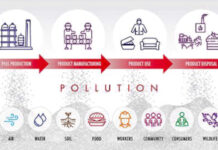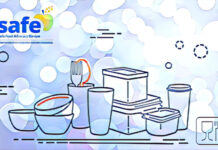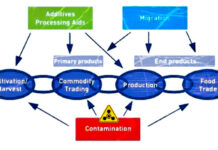The European Environmental Agency (EEA) has published the report ‘The State of Water in Europe 2024’, which collects and processes data from 20 countries on the condition of the Old Continent’s water bodies (1,2).
There is no shortage of critical issues, including droughts and floods, persistent pollutants and the risk of extinction of some plant and animal species, and therefore loss of biodiversity. What is lacking, as always, is the political determination to address them.
1) The state of Europe’s waters 2024, EEA report
The substantial acquis communautaire and policies for the protection of water resources have not yet produced significant improvements. (3)
Critical issues concern the quantity and quality of water, as well as the devastating effects that climate change expresses through alternating droughts and floods.
2) Surface water quality
The Environment European Agency (EEA) reports that among surface waters
– 71% are affected by chemical pollution
– 63% are in poor ecological conditions.
The worst chemicals leaking into surface water come from three sources:
– air pollution from coal-fired power plants
– leaching of agrochemical products from conventional agriculture (i.e. pesticides, herbicides, fungicides, fertilizers)
– fallout of polycyclic aromatic hydrocarbons, resulting from the combustion of solid fuels.
3) Forever chemicals
The European Environment Agency attributes a harmful role to some pollutants that persist for a long time. Such as mercury (released into the atmosphere by coal combustion) and brominated flame retardants (now banned), without which ‘80% of surface waters would reach a good chemical status instead of the 29%’.
The current calculations do not, however, take into account other forever chemicals such as PFAS, substances which are ‘harmful to human health and are widespread where they have been studied (4), but for which we currently do not have good knowledge of their overall presence in water at a global level’. (5)
4) Groundwater, the water supply
The condition of groundwater – which provides two-thirds of the EU’s drinking water and supports ecosystems such as wetlands and rivers – is also of concern.
In fact the Agency notes that
– 9% is declining in quantity– 23% is in poor chemical condition.
The main pollutants are nitrates and pesticides.
5) Flood disaster
Heavy rains causing floods – devastating territories, with enormous economic damage – are inevitable. EEA attributes them above all to the warming of the planet and the seas.
In 2023 severe floods with loss of life have occurred in Italy, Norway, Slovenia and along the Mediterranean coast. And 2024 promises to be no less disastrous.
Adaptation to these phenomena is indicated in ‘nature-based solutions’to improve water retention and “slow the flow”water.
6) Restoring water courses
The report’s authors recall that ‘achieving free-flowing rivers and restored wetlands is essential for healthy, biodiverse freshwater ecosystems.’
This approach is no longer available in some areas where dams, canals, cementing and ‘burial’ of waterways no longer allow to absorb endless rains.
7) Drought and waste
The drought is in turn attributed by the European Environmental Agency to climate change.
‘Water management practices in Europe are poorly suited to cope with such rapid and large-scale changes, which will put water security at risk’.
EEA’s recipe plans to reduce water use and improve water efficiency, through
– reduction of losses
– use of water-efficient devices and processes
– implementation of water reuse
– modulation of water tariffs to reduce consumption and finance water investments.
Tariff increases would also trigger popular revolts in some countries, such as Italy, already afflicted by an unsustainable cost of living and sometimes failed management of aqueducts.
8) Biodiversity of aquatic systems
‘Europe’s aquatic ecosystems are still severely degraded. Additional evidence reported under the Habitats Directive shows that only 17% of protected river, lake, alluvial and riparian habitats are in a good conservation status (2013-2018)’, EEA reports.
‘The vast majority of protected fish and amphibians species are in poor or bad conservation status. They risk local extinction and require remedial action. This shows that the EU is far from achieving its objectives for biodiversity in aquatic ecosystems’.
9) Improving Europe’s water resilience
‘The deadline set by the Water Framework Directive (WFD) for Europe’s rivers, lakes, transitional waters, coastal waters and groundwater to achieve good status was 2015. This date has not been met and little improvement has been seen since 2010., attests the report ‘State of water in Europe 2024’.
Instead of continuing to publish strategies, policies and proclamations that are dissociated from reality, European and Member State politics should immediately affirm the responsibilities of local authorities in the administration of public affairs for the pursuit of the objectives already established. In addition to allocating the resources necessary for the protection of the most primary of goods, water.
Marta Strinati
Footnotes
(1) EEA report 07/2024. Europe’s state of water 2024: the need for improved water resilience. Environment European Agency. 15.10.24 https://www.eea.europa.eu/en/analysis/publications/europes-state-of-water-2024
(2) The 19 Member States that transmitted data are Austria, Belgium, Croatia, Czech Republic, Denmark, Estonia, Germany, France, Italy, Latvia, Lithuania, Luxembourg, Netherlands, Poland, Portugal, Romania, Slovakia, Spain, Sweden. Absent are Bulgaria, Ireland, Greece, Cyprus, Hungary, Malta, Finland
(3) The EU environmental and climate policies relating to surface water and groundwater are Eighth Environment Action Program to 2030, EU biodiversity strategy for 2030, Farm to fork strategy, Water scarcity and drought communication and policy review, EU strategy on adaptation to climate change, Zero pollution action plan for air, water and soil, Chemicals strategy — for sustainability, towards a toxic-free environment, Second circular economy action plan, Soil strategy, Sustainable Development Goal 6, Sustainable Development Goal 11.5, Sustainable Development Goal 15
(4) Marta Strinati, Ylenia Desiree Patti Giammello. PFAS pollution, almost four thousand more deaths in 30 Veneto municipalities. GIFT (Great Italian Food Trade). 25.6.24
(5) Marta Strinati, Dario Dongo. PFAS in rainwater and food, global ban urgently needed. FT (Food Times). August 26, 2022
Professional journalist since January 1995, he has worked for newspapers (Il Messaggero, Paese Sera, La Stampa) and periodicals (NumeroUno, Il Salvagente). She is the author of journalistic surveys on food, she has published the book "Reading labels to know what we eat".








